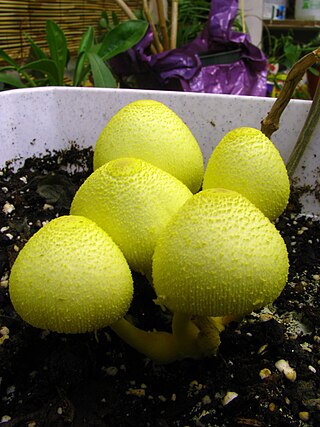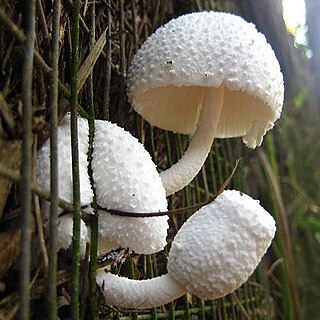
Leucocoprinus is a genus of fungi in the family Agaricaceae. Its best-known member is the distinctive yellow mushroom Leucocoprinus birnbaumii, which is found in plant pots and greenhouses worldwide. The type species is Leucocoprinus cepistipes. The genus has a widespread distribution and contains over 80 recognised species, however many of these species are very scarcely recorded and little known with only a small number of Leucocoprinus species which are commonly observed. The majority of the species in this genus are exclusive to tropical environments however numerous species have become a common sight in plant pots and greenhouses resulting in them becoming well known worldwide.

Leucoagaricus is a genus of mushroom-forming fungi in the family Agaricaceae. As of March 2023 there are over 200 accepted species of Leucoagaricus with ongoing research into the genus adding several more each year. Leucocoprinus is a similar genus and considered by some sources to be indistinct from Leucoagaricus based on genetic data that demonstrates they are monophyletic. Species are separated into these genera based on macroscopic features such as cap striations in Leucocoprinus or the more persistent basidiocarps (mushrooms) of Leucoagaricus as well as microscopic features such as the lack of a germ pore in Leucoagaricus species. As a result of the similarities and disagreement on taxonomy, many of the species within these genera have formerly been classified in the other and may still be known by previous classifications. For instance the species Leucoagaricus gongylophorus is cultivated by fungus-growing ants but was formerly known as Leucocoprinus gongylophorus whilst other species cultivated by the lesser attine ants are still classified as undescribed Leucocoprinus species.

Leucocoprinus cretaceus is a species of mushroom producing fungus in the family Agaricaceae. It is likely tropical in origin although it was first documented in Europe where it was often found growing in greenhouses and bark beds. However many early observations conflate this species with Leucocoprinus birnbaumii or Leucocoprinus cepistipes despite sharing only some superficial similarities. This fungus is quite versatile even for a saprotroph and is often found growing in clusters on woodchips, sawdust and compost heaps as well as directly from the ground or on trees. It may also appear in plant pots and greenhouses in colder countries in which it is not well equipped to survive outside.
Leucocoprinus straminellus is a species of mushroom producing fungus in the family Agaricaceae. Like other Leucocoprinus species it may have originated in a tropical climate but now finds a home in plant pots, greenhouses and compost piles in many countries. Leucocoprinus straminellus is described as being similar to the more commonly known Leucocoprinus birnbaumii but it is smaller and a lighter shade of yellow with smaller spores that lack a germ pore. It is also described as being superficially similar to Leucocoprinus fragilissimus but slightly more robust with flesh that is less translucent.

Leucoagaricus meleagris is a species of fungus in the family Agaricaceae.
Leucocoprinus medioflavus is a species of mushroom producing fungus in the family Agaricaceae.
Leucocoprinus acutoumbonatus is a species of mushroom producing fungus in the family Agaricaceae.
Leucocoprinus pusillus is a species of mushroom producing fungus in the family Agaricaceae.
Leucocoprinus beelianus is a species of mushroom producing fungus in the family Agaricaceae.
Leucocoprinus discoideus is a species of mushroom producing fungus in the family Agaricaceae. In the local language when the mushroom cap is open it is known as batakania or bepokua pembe when it is immature with a closed cap. However 'bepokua' may also be used to refer to other similar looking mushroom species such as Micropsalliota bambusicola.
Leucocoprinus elaeidis is a species of mushroom-producing producing fungus in the family Agaricaceae. In the local language, it is commonly known as elela.
Leucocoprinus thoenii is a species of mushroom producing fungus in the family Agaricaceae.
Leucocoprinus violaceus is a species of mushroom producing fungus in the family Agaricaceae.
Leucocoprinus velutipes is a species of mushroom producing fungus in the family Agaricaceae.
Leucocoprinus submontagnei is a species of mushroom producing fungus in the family Agaricaceae.
Leucocoprinus antillarum is a species of mushroom producing fungus in the family Agaricaceae.
Leucocoprinus scissus is a species of mushroom producing fungus in the family Agaricaceae.
Leucocoprinus domingensis is a species of mushroom producing fungus in the family Agaricaceae.
Leucocoprinus parvipileus is a species of mushroom producing fungus in the family Agaricaceae.
Leucocoprinus tephrolepis is a species of mushroom producing fungus in the family Agaricaceae.



